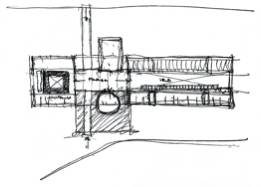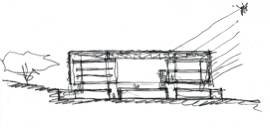

Brasiliana USP Project
Concept and Overall Direction
István Jancso
Project commission
Director
István Jancso, Professor, Institute for Brazilian Studies
Ana Lúcia Duarte Lanna, Director of the Institute for Brazilian Studies
Pedro Puntoni, Director of the Biblioteca Brasiliana Guita e José Mindlin
Antonio Marcos Aguirra Massola, Executive Director of the Fundação de Apoio à Universidade de São Paulo (University of São Paulo Development Foundation)
Eduardo de Almeida, architect
Rodrigo Mindlin Loeb, architect
Cyro Pessoa, engineer
Mariah Villas Boas, assistant director for planning
Cristina Antunes, Biblioteca Mindlin
Mamagement
University of São Paulo Development Foundation (Fundação de Apoio à Universidade de São Paulo)
Support provided by
Brazilian Ministry of Culture
Lampadia Foundation
FAPESP (The State of São Paulo Research Foundation)
Sponsors
Petrobrás
Telefônica
CBMM
1. The Project
The Brasiliana USP is a project of the Dean’s Office of the University of São Paulo that is to be designed and carried out by two institutions: the Institute for Brazilian Studies (IEB) and the Biblioteca Brasiliana Guita e José Mindlin (BBM). The partnership brings together two highly mature institutions with decades of collective experience: the IEB, comprising four and a half decades of dedication to research and teaching, while, at the same time, maintaining a documentary and bibliographic collection that is unique within the Brazilian university system; and the BBM, a collection built up over the course of nearly seventy years, which prior to its being donated to the University was considered in qualitative terms to be the most valuable private book collection in Brazil.
With this Project, the University will make available for research and instructional purposes the world’s largest collection of Brazilian materials managed by a university, access to which will be provided via the Internet (World Wide Web). However, the primary purpose of the Brasiliana USP Project will always be to carry out the University’s institutional goals – graduate and postgraduate research, and the communication of these results – within the strategic sphere of the nation.
The Brasiliana USP project will be housed in a building at the heart of the São Paulo campus, between the Dean’s Office and the Departments of Philosophy, Letters and Human Sciences. The 20,000 square meter structure, which is currently under construction, was designed according to the most rigorous professional standards for a building of its kind by the architectural firms of Eduardo de Almeida and Rodrigo Mindlin Loeb, with the assistance of the School of Architecture and Urbanism of the University of São Paulo (FAU). This team modeled its project upon the most esteemed North American libraries, including the Beinecke Library of Yale University, the J. Pierpont Morgan Library, the New York Public Library, and the Library of Congress, as well as the National Library of France. In addition to maintaining the collections of its constituent libraries, guaranteeing optimal conditions for its users, and carrying out its regular activities of research, instruction, and public outreach, the new building will house the project of constructing a Digital Library of Brasiliana, documentation relating to Brazil.
2. The Brasiliana Of The University Of São Paulo
The University of São Paulo is the safe-keeper of one of the largest collections of Brasiliana in Brazil. Despite a highly diversified set of holdings that includes manuscripts and works of art, pride of place is reserved for its collection of books. Through the donation of Guita and José Mindlin’s collection, the Brasiliana of the University has acquired a unique shape and depth, and for this very reason has taken on a significant responsibility to the Brazilian nation as a whole. By necessity, access to such a collection should be expanded and democratized. In order to accomplish this strategic goal, a digital library will be created that will serve principally as a reference library, in addition to being a functional and useful instrument for instruction, study and research into Brazilian themes and topics.
The Brasiliana USP project emerges out of a strategic agreement between two institutions, the IEB and the BBM, whose purpose is to preserve and protect documents and bibliographic material for research into Brazilian themes. The project’s larger goal, however, is to involve the entire university community and, if successful, to offer a model for expanding its Brazilian documentary and bibliographic collection via the Internet.
2.1. Biblioteca Brasiliana Guita e José Mindlin (Guita and José Mindlin Library of Brasiliana)
The “Biblioteca Brasiliana Guita e José Mindlin” (BBM) is a unit of the Associate Dean’s Office of Culture and Extension of the University of São Paulo. It was created in January 2005 to house and unify the repository of Brasiliana assembled over the course of eighty years by the collector and bibliophile José Mindlin, who, in conjunction with his wife Guita and their children, donated the collection to the University of São Paulo in a gesture of extraordinary generosity toward the Brazilian nation. With its thematically suggestive selection of books and manuscripts, the BBM Brasiliana is considered to be the most important collection of its kind amassed by a single individual. It holds nearly 15,000 titles, comprising 40,000 volumes: works of Brazilian (and Portuguese) literature, travel narratives, historical and literary manuscripts (including originals and typographical proofs), periodicals, scientific and instructional texts, iconography (including plates and illustrated albums) and artistic books (engravings). A portion of the donated collection belonged to the renowned bibliophile Rubens Borba de Moraes, whose library was maintained by Guita and José Mindlin after the former’s death. Among the countless treasures, a number of works are particularly noteworthy: Von Martius’s Flora Brasiliensis (40 volumes), together with a complete set of the naturalist’s published works; one of the most complete collections of works by travelers and visitors to Brazil, from the sixteenth to the nineteenth centuries; the principal works from the Dutch period, with editions of Barlaeus and Montanus, as well as a nearly unique collection of Dutch pamphlets from the first half of the seventeenth century; first editions of several important literary figures from the nineteenth and twentieth centuries; rare manuscripts, including one of the few known copies of Gabriel Soares de Souza’s “Notícia do Brasil” (1580), a unique copy of the first edition of the Relation de la Mission des indiens Kariris du Brésil, written by Father Bernard de Nantes in 1712; the first editions issued from the royal printing press in Brazil at the beginning of the nineteenth century; and collections of (extremely rare) scientific journals from the nineteenth and twentieth centuries. In short, Guita and José Mindlin’s library of Brasiliana is a unique collection: it has been awarded numerous prizes and is admired and recognized throughout Brazil and the world as the result of a lifetime of dedication, a passion for the written word, and a love for Brazilian culture in all of its manifestations.
2.2. O Instituto de Estudos Brasileiros (Institute for Brazilian Studies)
The Institute for Brazilian Studies was created in 1962 through the initiative of historian Sérgio Buarque de Holanda. It is a unit that provides research space for scholars from diverse fields and, in addition to allowing for the organization and examination of primary sources that comprise its collection, brings together documentation that supports research projects related to the history and culture of Brazil.
The repository itself contains an important collection of personal archives of several Brazilian artists and intellectuals, distributed throughout the Institute’s Archive, Library and Visual Arts Collection. The unique character of the collection as a whole rests on its diverse array of materials: original manuscripts by individuals who have made outstanding contributions to Brazilian culture, rare books, works of art, and other more recent acquisitions made through donations or purchases. The Library contains more than 140,000 volumes (including special collections, books and periodicals). The Archive holds nearly 400,000 items, among which are included manuscripts, letters, photographs, sheet music, sketches, and other documents produced by such important Brazilian intellectuals as Mário de Andrade, Anita Malfati, Camargo Guarnieri, Caio Prado Júnior, Fernando de Azevedo, Graciliano Ramos, Guimarães Rosa, Ernani Silva Bruno, José Honório Rodrigues, Milton Santos, Pierre Monbeig, Osman Lins, the Baron of Itararé, et al. The Visual Arts Collection comprises some 3,000 objects, which come primarily from the extraordinary collection of Mário de Andrade.
Without question, this collection represents the largest repository of Brasiliana of the University of São Paulo and is recognized as among the most important in Brazil. Because of the Institute’s interface with the scholarly community, its daily activities make it a laboratory for new methods and new techniques of conservation and cataloguing. For this reason, the Institute for Brazilian Studies serves not only as a center for research into subjects relating to Brazilian history and culture, but also as a site of innovation for the latest applied information technologies.
In the last few years, the IEB has undergone an intense process of reorganization and renovation. The Institute has hired new professionals, including both curators and technicians, developed projects bringing together curators and researchers from other centers at the University, and increased its schedule of courses, seminars, and cultural events for scholars and the broader public. As an educational center for training archivists and paleographers, the Institute is currently in the process of developing a graduate program stricto sensu in archival organization.
3. A New Building
The BRASILIANA USP project will be housed in the heart of the USP campus, between the Dean’s Office and the Departments of Philosophy, Letters and Human Sciences.

The 20,000 square meter building, currently under construction, was designed according to the most rigorous technical requirements by the architectural firms of Eduardo de Almeida and Rodrigo Mindlin Loeb, with the assistance of the School of Architecture and Urbanism of the University of São Paulo (FAU). It is scheduled to open in 2009.

4. The Digital Library Of Brasiliana
The University of São Paulo maintains a bibliographical and documentary collection related to Brazilian themes and topics that is unparalleled both in Brazil and in the rest of the world. The magnificent resources of the Biblioteca Brasiliana Guita e José Mindlin and Institute for Brazilian Studies are important components of this collection. Because the University felt a responsibility to increase access to its collections, and was fortunate at the same time to have the technical and technological capabilities to undertake such an initiative, the BRASILIANA USP project was conceived as a strategic imperative: a project to create the Digital Library of Brasiliana comprising a national network of public and private institutions that are willing to take part. Through this initiative, the University of São Paulo will provide unrestricted access to public collections of scholarly documentation and other information that it maintains.

The proposal to create a Digital Library of Brasiliana is based upon several distinct principles. The organization of a digital library should be based upon its intended use, including scholarly research and investigation; formal and informal education; and the desire for knowledge and cultural formation on the part of members of society at large. Given this orientation, the library is not intended to be a collection of rare books, nor does it seek to represent itself as a privileged repository of cultural patrimony. Rather, moving away from a disposition that is proprietary in nature, the project seeks to construct a reference library that will rapidly become an instrument for research and investigation. This digital library will serve as a virtual showcase for the magnificent collection of the University, beginning with the combined resources of the IEB and the BBM. Over time, the digital project may offer a model for the technological management of a collection that can be used by other libraries, archives, and public and private institutions. As such, the Digital Library of Brasiliana can be seen as an instrument that will multiply its impact in a variety of spheres: not only making access universal, but also democratizing the means to consolidate the national memory and provide a broader and more inclusive perspective on Brazilian culture.
For more information, please consult www.brasiliana.usp.br
Copyright
2007, ISSN 1645-6432
e-JPH, Vol.5, number 2, Winter 2007